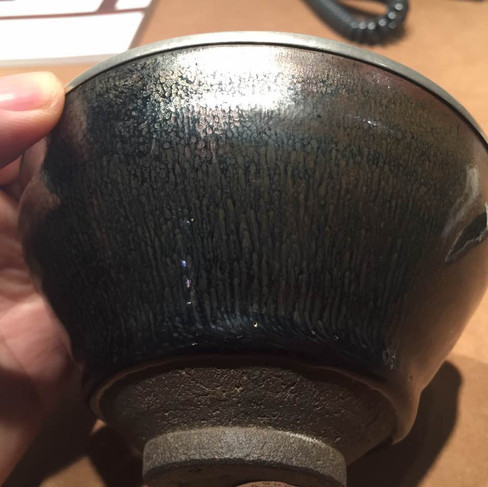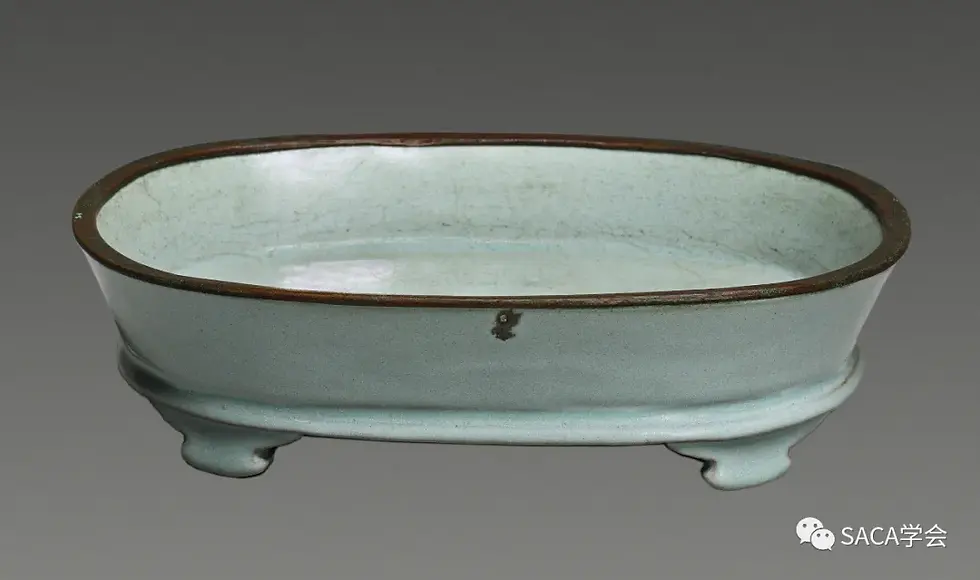宋代筆記 vol.51 羅傑琵金頓985.5萬港元南宋建窰禾目天目茶盞 - Song Notes: An Exceptional And Rare Heirloom 'Jian' Silver-Streaked 'Nogime Temmoku' Tea Bowl Southern Song Dynasty.
- SACA

- Apr 24, 2024
- 7 min read

宋代建窯茶碗是宋磁當中十分特殊的存在。五大名窯的概念來自明代的紀錄,而建盞的宮廷使用,精確到宋徽宗本人的使用,卻是十分明確的宋代記錄。因此,何謂官窯這個概念,十分有趣。
當然本文並不是為了推進建盞成為官窯。想當官發財,有皇帝的崇拜和衝動,是許多平民的畢生幻想,但擁有一個皇帝用過的器物,並不會讓自己的地位發生任何改變,更不會讓自己的審美發生任何劇變。收藏官窯,並不是收藏的重點,審美的探索要複雜的多。是不是官窯,並不重要。建窯茶碗就是這樣的一個宋代物證,他不是明人的五大名窯,但卻是最受歡迎的宋瓷品種。
全世界熱衷宋代點茶的茶人都需要一件,從用戶角度來說,無論無何,這也是最受歡迎的宋瓷品種。實際上,在日本,國寶中就有4件建盞,而汝窯、官窯卻一件也不是國寶。
這件建盞是毫無疑問的日本傳世品,相信在20世紀初,大正年間離開日本。當時日本正在經歷一場劇變,許多寶物都從貴族轉移到財閥手中。這件作品先被Plesch收藏,他是重要的東方陶瓷學會成員,其父是愛因斯坦的醫生;後被鐵路大王Pilkington收藏,這是一個徹徹底底的大家族,羅傑琵金頓只用了很短的時間收藏,但選品的級別卻很高。
SACA學會發表過關於Plesch的收藏文章:《汝窑水仙盆与东方陶瓷学会普莱施的中国艺术收藏 - OCS, Peter Plesch Collection.》
收藏家中確實有這樣的天賦異稟的人,這無疑是令人悲欣交集的一種存在。悲哀的是,許多庸俗的藏家,自命不凡,折騰了一輩子,最後被某一些特立獨行的人,輕而易舉的擊潰。只能說,在審美面前,雖說人人平等,但細想又是極度不公平的。
蘇軾說,人肥尚可瘦,士俗不可醫,卻是如此。一個庸俗的藏家是無可救藥的,一個偉大的藏家,卻是不可阻擋的。
Estimate
12,000,000 - 16,000,000 HKD
Lot Sold
9,855,000 HKD
2016年 584萬港元,四年將近翻倍。這也是因為對於建盞的認知、對傳世的理解趨於成熟,另外一個原因就是宋代文化的潮流興起。
青山居珍藏
南宋 建窰禾目天目茶盞
superbly potted, the deep rounded sides rising from a short straight foot to a rim indented with a thin concave groove, unctuously covered with a lustrous black glaze with iridescent silvery-blue ‘hare’s fur’ streaks, the glaze draining from the rim and falling short of the foot in a glossy black bulge revealing the dark brown body, the rim bound with metal, Japanese wood box
12 cm, 4 ¾ in.
Collection of Peter Hariolf Plesch (1918-2013), until 1959.
Sotheby's London, 17th March, 1959, lot 7.
Bluett & Sons Ltd, London, 1959.
Collection of Roger Pilkington (1928-1969), from 1959, and thence by descent.
Sotheby's Hong Kong, 6th April 2016, lot 12.
Peter Hariolf Plesch(1918-2013年)收藏,至1959年
倫敦蘇富比1959年3月17日,編號7
Bluett & Sons Ltd,倫敦,1959年
羅傑琵金頓(1928-1969年)收藏,1959年始,自此家族傳承
香港蘇富比2016年4月6日,編號12
禾目銀輝
康蕊君
建窰黑釉茶盌之賞鑑,與日本茶道宗師與收藏家息息相關,在日本,宋代建窰茶盞廣得崇敬愛慕,其日文名稱「天目」也隨之流傳千里,成為現今通稱此類黑釉器盞之名。
古時,黑釉茶盞多藏於佛寺,用之奉茶以養身心,茶盌質樸素雅,合適作為供佛儀典之器。盞沿下一圈微斂,為持用方便而設,胎厚紮實,保茶汁溫熱而不燙手,釉黑潤亮,托襯宋時點茶擊拂茶水後,所得茶面細沫,白黑相映,瞬息美哉。
點茶法保存於日本茶道傳統,黑釉建盞則與浙江臨安天目山淵源深遠,天目山以高聳日本古松聞名,乾隆帝南巡亦曾造訪,天目茶現仍馳名。宋時,日本僧人或許將天目盞與福建產茶一起帶回本國寺院,傳承至今依舊深受敬仰,數件已定為國寶文物。
福建建陽窰致力於燒製茶盞,年年進貢內廷,宋徽宗重文愛藝,茶學造詣且精,對於建陽茶盞亦是傾愛不已。
1930年代派駐福州海關的美國官員 James Marshall Plumer(1899-1960年),於當地古董商行發現此類黑釉建盞後,大為傾心。1935年決心深入福建尋覓窰址,路途艱難,原為駕車,行至第四條激流處,為渡河只得棄車乘舟,後轉搭火車、公車、竹筏、郵船、步行等,沿途中不僅需收買驛站人員,以求保身,且數度遇洪水沖塌路橋,滯難重重。Plumer 最終在水吉一帶定位建陽窰址,他的研究推廣與專著,《Temmoku: A Study of the Ware of Chien》,東京,1972年,使建盞名揚西方。
建盞黑釉耀眼,釉色變化多樣,窰燒時,釉裡氣泡爆裂,流釉成絲絲細紋,稱之兔毫(日文「禾目」),或釉面圓點緻密之樣,稱為油滴(日文「油滴」),色調紅褐至耀藍皆可見,褐釉兔毫可說最具代表性,泛藍油滴釉則是盛名且罕見,二者之間可見無數種釉色變化,決定建盞之價值與魅力。此件兔毫茶盞釉色亮澤,金銅色細毫隱隱閃耀銀光,乃禾目品類中最珍稀者。
《唐物天目》,茶道資料館,京都,1994年,收錄一系列天目盞,包括數件日本國寶及福建出土作例,其中京都國立博物館與德川美術館藏禾目建盞,類同此件拍品,銅褐色細毫泛銀輝,頁19ff,圖版10、13、15、16。成功燒出如此釉色者甚少,建窰遺址碎片堆中亦是少見,僅發現寥寥數例,刊於前述出處,頁64ff,圖版47右下、48、61,頁103,參考圖版E。
多位學者皆曾探討建盞盌心積釉略偏之現象,Marshall P.S. Wu 專文中指出,此應源自於燒造時,建盞以略微傾斜角度置於匣缽內,用以避免流釉沾黏(Marshall P.S. Wu,〈Black-glazed Jian Ware and Tea Drinking in the Song Dynasty〉,《Orientations》,卷29,4號,1998年4月,頁22ff,圖2-5)。
Nogime Temmoku with a Touch of Silver
Regina Krahl The love and connoisseurship of black-glazed tea bowls from Fujian is intimately connected with the homage paid to these ceramics by Japanese collectors and tea masters. In Japan, ‘Jian’ ware tea bowls were revered virtually from the moment they left the kilns in the Song dynasty (960-1279), and the Japanese term temmoku (or tenmoku) is now universally accepted for this group of black-glazed bowls, as lasting testimony of this reverence.
Black tea bowls were particularly appreciated in Buddhist monasteries, where tea was drunk for its beneficial effects on body and mind as well as ritually offered to the Buddha. The seemingly humble aspect of black tea bowls made them particularly appropriate in this context. The groove below the rim made them comfortable to hold, their heavy potting had an insulating effect, keeping the tea inside hot while protecting the fingers outside from the heat, and their dark interiors made for a striking contrast with the white froth of whipped tea.
In Japan, where whipped tea continues to be ritually prepared and consumed in the Tea Ceremony, black ‘Jian’ tea bowls became associated with monasteries in the Tianmu (Japanese: temmoku) mountain range in Lin’an county, north Zhejiang province, now a nature reserve renowned for its giant ancient Japanese cedar trees, visited also by the Qianlong Emperor (r. 1736-95) and still famous for its Tianmu tea. Temmoku tea bowls were probably brought to Japan together with Fujian tea by Buddhist monks visiting Chinese monasteries in the Song dynasty. They are still worshipped in Japan today, several of them having gained the rank of National Treasures.
The Jianyang kilns of Fujian, which produced nothing but tea bowls, annually supplied them as tribute to the court and the Huizong Emperor (r. 1101-1125), one of China’s greatest imperial art lovers, patrons and tea connoisseurs, is known to have been fond of them.
‘Jian’ ware became known in the West through the efforts of James Marshall Plumer (1899-1960), an American who in the 1930s worked at the Fuzhou Office of the Chinese Maritime Customs and fell in love with the black tea bowls offered in the city’s antique shops. Determined to locate the kilns, he set out in 1935 on a perilous journey to this remote and at that time dangerous rural area in inner Fujian, first travelling in his own car, which he had to abandon at the fourth river crossing, then by ferry boat, carrying on by rail, rickshaw, bus, bamboo raft, mail boat and on foot, bribing highwaymen to secure safe passage, but often stopped by floods that had carried away parts of the road or a bridge. He was the first to locate the kilns in the region of Shuiji and through his teaching and a posthumously published survey made the ware widely known, well beyond the circles of tea lovers in China and Japan (James Marshall Plumer, Temmoku: A Study of the Ware of Chien, Tokyo, 1972).
The striking black glazes can show various different effects, when air bubbles in the glaze burst, leaving a pattern of streaks, compared to hare’s fur (Japanese nogime), or spots compared to oil spots (Japanese yuteki), that can range in tone from rust brown to metallic blue. While pieces with rust-brown ‘hare’s fur’ streaks are the best known and most characteristic ‘Jian’ ware tea bowls, those with bluish ‘oil spots’ are the rarest and most celebrated. In between, there exists an endless variety of different glaze effects, for which no specific names have been coined, which determine the relative desirability of ‘Jian’ tea bowls. With its sparkling glaze interspersed with metallic silvery to coppery steaks, the present bowl is among the rarest and most highly coveted nogime examples.
A wide range of different temmoku bowls is published in Tōbutsu temmoku [Import commodity ‘temmoku’], Chadō Shiryōkan, Kyoto, 1994, including some of the finest examples preserved in Japan as well as bowls excavated in Fujian province. Among the former, most closely reminiscent of the present bowl, also with metallic shimmering, copper-coloured streaks, are bowls from the Kyoto National Museum and the Tokugawa Art Museum, pp.19ff, pls 10, 13, 15, 16. This effect of the iron-brown specks taking on this metallic sheen is so rare that it is hardly encountered among the many wasters found at the kiln site, and only a few comparable fragments are illustrated ibid., pp. 64ff., pls 47 bottom right, 48 and 61, and p. 103, reference pl. E.
The characteristic feature of ‘Jian’ tea bowls of the glaze inside having pooled off-centre, which has been remarked by many scholars, has been discussed in an article by Marshall P.S. Wu, who suggests that a deliberately oblique setting of the bowls in the saggar helped to avoid the formation of stalactiform glaze drops that might stick to the saggar (Marshall P.S. Wu, ‘Black-glazed Jian Ware and Tea Drinking in the Song Dynasty’, Orientations, vol. 29, no. 4, April 1998, pp. 22ff, figs 2-5).







































Comments